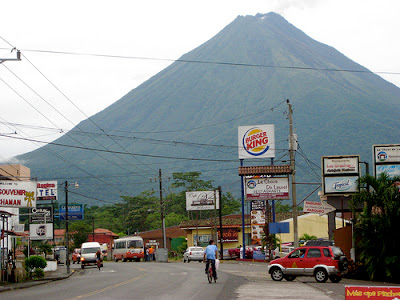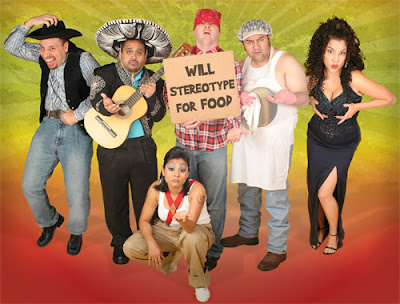I was talking with David, Dago, and Kevin this morning about stereotypes. We were talking about when teams or gringos come down here and are surprised at what they find...I decided to blog some of the stereotypes they find ironic that people from the USA have when they come here:
 |
| San Jose at night |
 2. Yes they do eat fast food here. There is a McDonald's, Taco Bell, Burger King, Subway, Quiznos, TGI Friday's, Hooters, and Outback Steak House within WALKING distance of Los Anonos. Of course the food is cheap, so it does cater to those who don't make hardly any income. It is really adding the the diabetes and obesity in the poorer classes since it takes money away from healthier foods such as fresh produce.
2. Yes they do eat fast food here. There is a McDonald's, Taco Bell, Burger King, Subway, Quiznos, TGI Friday's, Hooters, and Outback Steak House within WALKING distance of Los Anonos. Of course the food is cheap, so it does cater to those who don't make hardly any income. It is really adding the the diabetes and obesity in the poorer classes since it takes money away from healthier foods such as fresh produce.3. Yes, they have the internet here. Most of them have it in their houses. Most of them can access it either with phones or computers. They also have cable and big screen tv's. While their houses are not up to our standards or what we would consider livable, they still have access to the same technology. It is always interesting to me to walk into a house that from the outside looks like it is going to fall down but still find a tv inside. For many people, it is a form of escape. To escape the life of poverty and think on something other than their house. Of course some times they have cable and internet and electricity illegally, too...they high-jack it in from neighbors...That's a whole other topic. Some technological items are also exceptionally cheap here...You can get a really cheap cell phone for $40. A phone card costs you $5 and the phones can work like track phones, you pay as you go. Texting is cheap...about 100 for a few pennies. Calling is more expensive, but most people just text.
4. You would be surprised at what you can find inside some of these tin roof, scarp metal houses...tile floors, indoor plumbing, technology, furniture, etc. There are still people who use outhouses, but most of them have indoor plumbing. There are several houses in the community on outhouses, but the majority have indoor plumbing... Septic tanks are another matter. Much of the "black water" just runs into the rivers. Most houses here in our community don't have hot water, but they do have running cold water.
5. Yes, they have malls here. And Walmart. And movie theaters. They even have an IMAX. The mall here in San Jose, Multiplaza, a 15 minute bus ride from the community, has ridiculous like 400 stores. These stores include Gucci, Coach, Hush Puppies, Naturalizer, Ann Taylor, MNG, Abercrombie and Fitch, Aeropostale, Hilfiger, and other high-end stores I can't even afford to shop in. The malls here are not kind to the poor. Many people cannot afford to shop here, but there is a small part of the population that can.
6. They also have excellent health care here. They have hospitals and world renowned doctors, surgeons, dentists, and medical professionals. Yes, they have a city hospital which is probably like most inner city hospitals, overworked nurses, drug addicts looking to get in off the street, gun shot wounds, etc., but there are also really nice hospitals like CIMA, which has an excellent reputation. Of course only people with excellent health insurance can afford to go there. There are also a range of health clinics that offer medical care regardless of socioeconomic status. The poor would not be able to receive health care at CIMA for the cost.You do need to have social security here, though, to access services. Which makes it difficult for illegal immigrants to access the health care. There are still people who do get shut out of medical care. There are people who cannot afford the prescriptions their doctors prescribe for them. We know several members in the community with ulcers or other disorders that cannot afford the therapy or medicine to get better.
7. No, they don't dress in "typical, traditional" dress...there are indigenous people who dress in typical ways, but most people here wear jeans, t-shirts, and tennis shoes. They like the wear what you're wearing and stay in fashion with the USA.
 |
| The new national stadium in San Jose |
9. No, the entire country is not all poor. Costa Rica is one of the wealthiest Latin American countries. There is a HUGE population that live in poverty and approximately 10 percent of the population has been reported under the World Bank poverty line, (Read more: Costa Rica Poverty and wealth, Information about Poverty and wealth in Costa Rica http://www.nationsencyclopedia.com/economies/Americas/Costa-Rica-POVERTY-AND-WEALTH.html#ixzz1iPZTuxsq) but not everyone here is poor. There are bankers, lawyers, doctors, plastic surgeons, dentists, business owners, and wealthy tycoons. That is not to say that there is no poverty here. There are huge pockets of exceptionally poor communities. These communities have a very difficult time leaving their poverty. Minimum wage here is $3 an hour. Many items cost the same here as in the USA, such as clothing and some food products. That can make it difficult to live when rent on your 1 bedroom shack is $200-$300 a month.
10. Yes, they do have public education here. Higher level education, as well. They have universities and master's degrees. The system works different here, but they still have a good education system. All children can receive an education. The problem is the drop out rate. Many of the poorer kids drop out to start working to support their families and they never finish their education. They need help and encouragement to finish their education so they can get better jobs and leave the poorer communities.
11. Costa Rica is not an island. It is part of Central America and Nicaragua is attached to the north and Panama to the south. Yes, they are American. They are Latin Americans, which classifies them as American...
12. No, they do not use Mexican money. Or "American" money. They use Colones.
13. Yes, they are Americans, too. We are not the only Americans out there. In fact, Canadians, Mexicans, Peruvians, and Brazilians are also Americans. They are North American, South American, and Latin American. So when we refer to something as being "American", like "Oh, yeah, we eat french fries in America, too", it's kind of a misnomer here.
Some other stereotypes that we believe that are actually true:
1. Yes, they have a higher teen pregnancy rate than the USA. According to one statistic, a rate 50% higher. According to the same website, 27% of teen pregnancies in the United States were terminated by abortion. While detailed statistics are not available for Costa Rica abortion is not an option for most teen mothers in Costa Rica as therapeutic abortion is criminal act punishable by two years imprisonment. (http://www.usexpatcostarica.com/2010/08/teen-pregnancy-higher/)
2. Ok, one that is true, they do eat rice and beans almost every day. They are cheap and can be prepared in a ton of different ways. That one is true.....
3. They speak Spanish here. Yup. Also true. Although many of them are trying to learn English. It helps them get better jobs.
4. There is a huge struggle with drugs and alcohol here...especially in our community.
I could probably think of some others, but I think that's enough for now. For more information on Costa Rica as a country, check out the following websites:
www.lonelyplanet.com/costa-rica
en.wikipedia.org/wiki/Costa_Rica
www.infocostarica.com/
www.tourism.co.cr/
www.ticotimes.net/
thecostaricanews.com/





Julie, thank you for sharing this information. I'm Shannon's mom and I'm excited to learn more about CR before she comes for her stay in June. Also, this will be helpful for our church, as we prepare to send another team in August of this year. I'm going to share the link to this blog entry on our church's facebook page so that folks can begin getting more acquainted with Costa Rica.
ReplyDeleteI love that you posted this!!
ReplyDelete